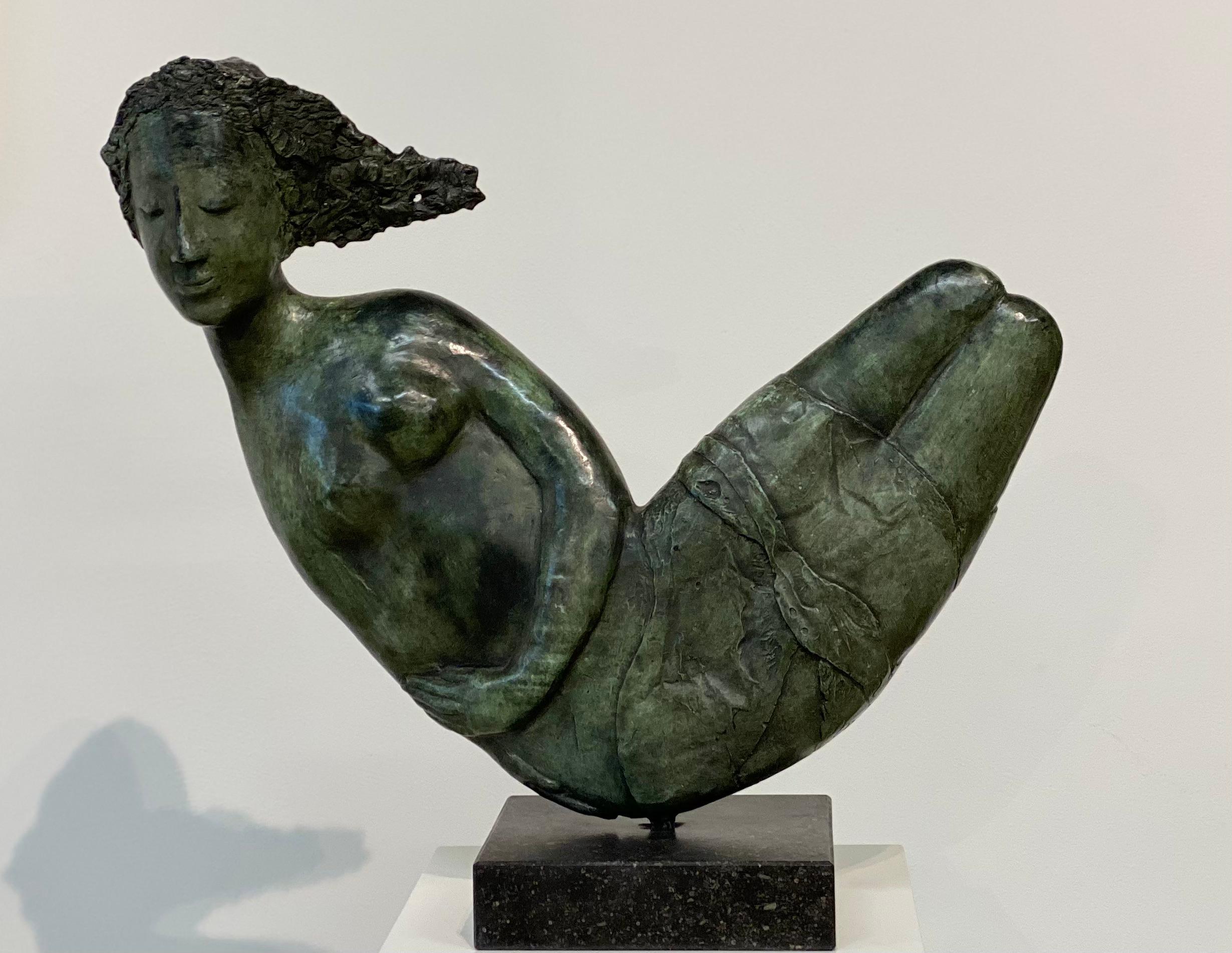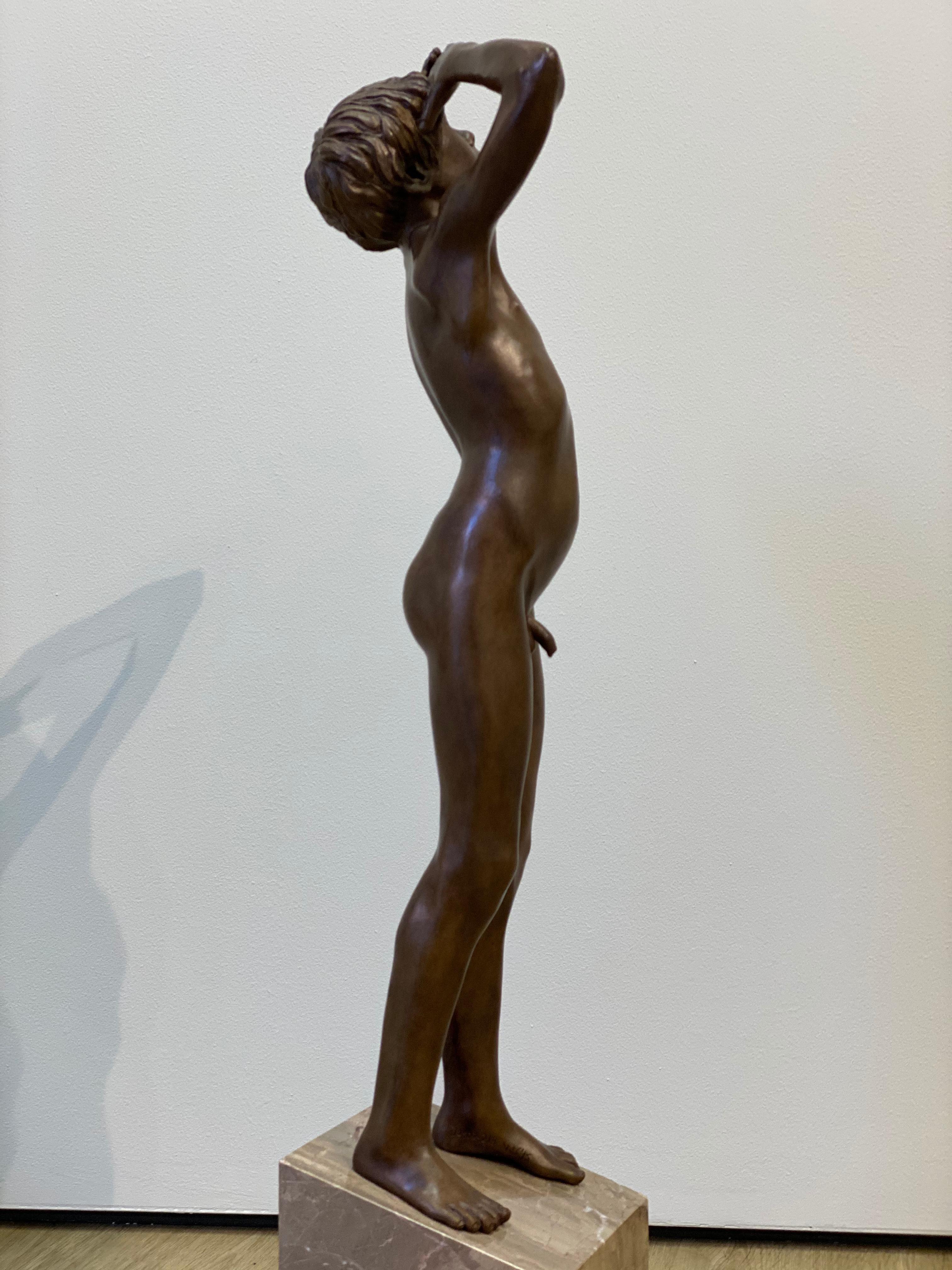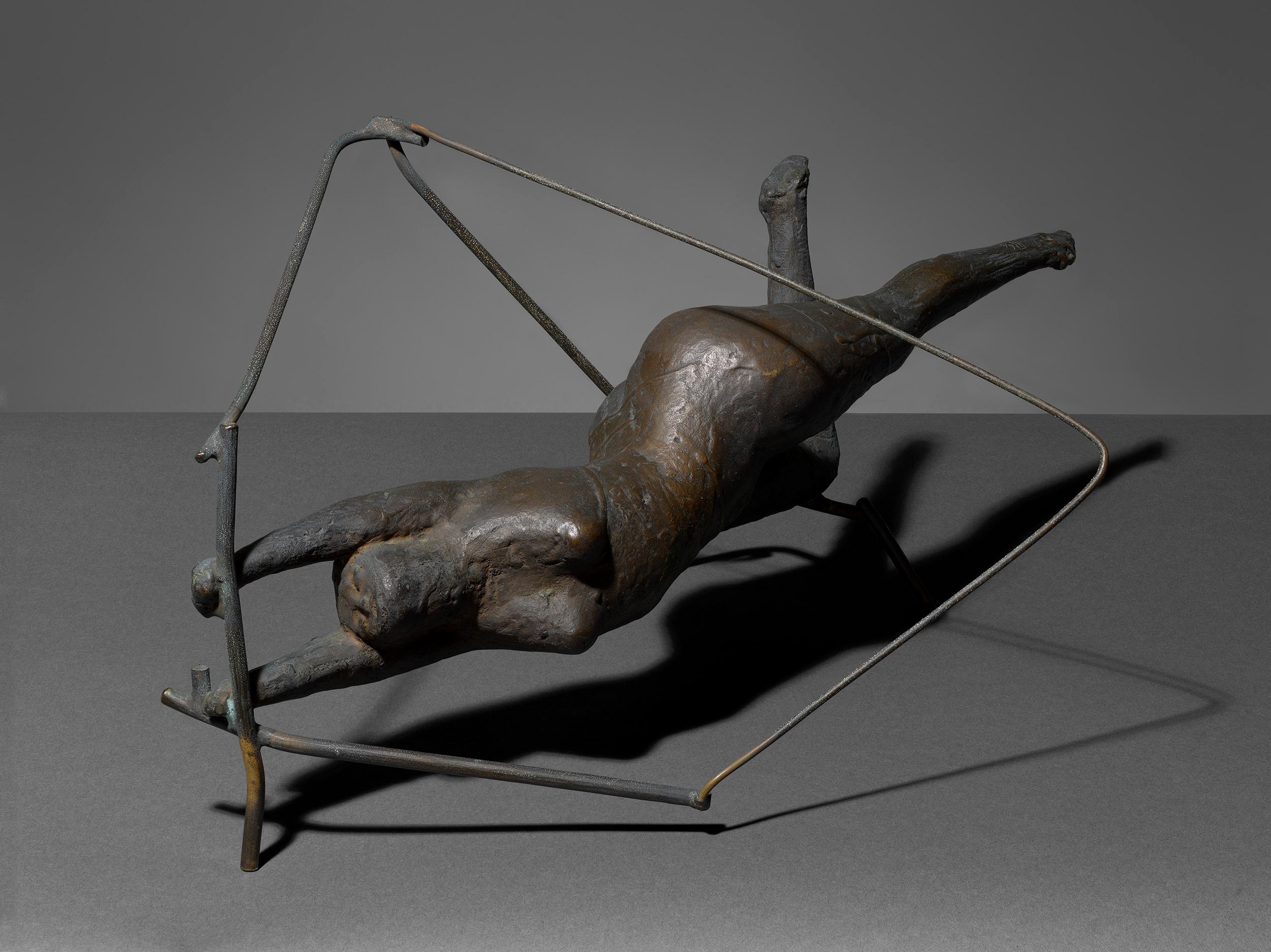Items Similar to Pan of Rohallion, 1889-90 classical bronze sculpture
Want more images or videos?
Request additional images or videos from the seller
1 of 7
Frederick William MacMonniesPan of Rohallion, 1889-90 classical bronze sculpture1889-90
1889-90
About the Item
Frederick W. MacMonnies (American, 1863-1937)
Pan of Rohallion, 1889-90 (Garden 22)
Bronze
Signed on base, 'ROMAN BRONZE WORKS NY' at base
14.25 x 4 x 6 inches
A sculptor of classical figures, American-born Frederick MacMonnies had fame in the United States and Europe in the later half of the 19th century and early 20th century. He occasionally returned to America but lived most of his life as in expatriate in France. He was especially known for his lithe bronze figures, especially ones titled Diana. The classical names of these figures allowed him the appearance of propriety but gave him the opportunity to model svelte nudes.
Frederick MacMonnies was one of the first American sculptors to recognize the potential market of the middle class. He copyrighted his works and then contracted with foundries to mass produce some of his figures such as Diana in smaller sizes.
MacMonnies was born in Brooklyn, New York, and was a child prodigy at carving stone. At age 18, he worked in the studio of Augustus Saint-Gaudens, and then persuaded him to become his assistant, keeping models damp and covered, running errands, and cleaning the studio. Evenings he studied at the Art Students League, Cooper Union, and the National Academy of Design.
In Saint-Gaudens' studio, he met many of the wealthy people who shared Saint-Gaudens Beaux-Arts based ideas that art and architecture should be unified in order to create public art in America equal to that of classical antiquity or Renaissance Europe. Among the men that MacMonnies met through Saint-Gaudens who later furthered his career were architects Stanford White and Charles McKim and John LaFarge, decorator of mansions of the wealthy including the Vanderbilts.
After four years of study and work in New York, MacMonnies left for Paris, opting for the more modernist techniques he could learn there over the more traditional sculpture teaching in Rome. One of his first teachers was Alexandre Falguiere, who had been an instructor of Saint-Gaudens and who injected a degree of contemporary realism into his classical figures. MacMonnies mingled with many upper class American expatriates and met his future wife, Mary Fairchild, a painter.
MacMonnies came home briefly to help Saint-Gaudens with a project and then gained admittance in Paris to the Ecole des Beaux Arts, where he did numerous classical figures inspired by the style of small bronzes of Renaissance Florence, Italy.
In 1889, he established his reputation with his sculpture of "Diana" at the Paris Salon. The execution of his nude sculpture was a challenge for a sculptor such as himself who strove for slim, well proportioned figures---the "aestheticizing of the nude". (Katz 12) In those days, most of the female models were poor peasants who were stocky with poor figures, distorted feet and often unbathed. However, MacMonnies found Marie Caira as the model for his Diana figures, and she, from a professional family of models, had the figure and social stature that met his criteria.
Although he chose to live in Paris, many of his public and private sculpture commissions in future years, with the help of Saint-Gaudens and also architect, Stanford White, were in the United States.
At the recommendation of Saint-Gaudens, he successfully entered the "Nathan Hale" competition for City Hall Park in New York City and had work at the 1893 World's Fair Exposition in Chicago. His work titled The Barge of State, a thirty-eight figure extravaganza, made him nationally famous. A bronze Bacchante of a female nude in riotous abandon caused a lot of controversy including being banned in Boston, but the attention brought him even more work.
- Creator:Frederick William MacMonnies (1863-1937, American)
- Creation Year:1889-90
- Dimensions:Height: 14.25 in (36.2 cm)Width: 4 in (10.16 cm)Depth: 6 in (15.24 cm)
- Medium:
- Period:
- Condition:
- Gallery Location:Beachwood, OH
- Reference Number:1stDibs: LU1768213715442
About the Seller
No Reviews Yet
Vetted Seller
These experienced sellers undergo a comprehensive evaluation by our team of in-house experts.
Established in 1975
1stDibs seller since 2022
9 sales on 1stDibs
Typical response time: 2 hours
- ShippingRetrieving quote...Ships From: Beachwood, OH
- Return PolicyA return for this item may be initiated within 14 days of delivery.
More From This SellerView All
- Harmony, 20th century bronze & green marble base, nude man and woman with lyreBy Max KalishLocated in Beachwood, OHMax Kalish (American, 1891-1945) Harmony, c. 1930 Bronze with green marble base Incised signature on right upper side of base 14 x 9 x 5 inches, excluding base 17 x 10 x 8 inches, including base Born in Poland March 1, 1891, figurative sculptor Max Kalish came to the United States in 1894, his family settling in Ohio. A talented youth, Kalish enrolled at the Cleveland Institute of Art as a fifteen-year-old, receiving a first-place award for modeling the figure during studies with Herman Matzen. Kalish went to New York City following graduation, studying with Isidore Konti...Category
1930s American Modern Figurative Sculptures
MaterialsMarble, Bronze
- Late 18th Century Bronze Sculpture after the Farnese HerculesLocated in Beachwood, OHLate 18th Century Bronze Sculpture after the Farnese Hercules Grand Tour bronze with a fine encrusted patination on a later wooden base 16 in. h., overall 12.5 in. h., bronze 3.5 in...Category
Late 18th Century Figurative Sculptures
MaterialsBronze
- Diana the Huntress, 1890 classical bronze sculptureBy Frederick William MacMonniesLocated in Beachwood, OHFrederick William MacMonnies (American, 1863-1937) Diana, 1890 Bronze with green verdigris patina Signed and dated Copyright 1894 with Jaboeuf & Rouard, Paris foundry mark 31 x 21 x 17 inches A sculptor of classical figures, American-born Frederick MacMonnies...Category
1890s Figurative Sculptures
MaterialsBronze
- Nude Walking, Early 20th Century Bronze Sculpture, Cleveland School ArtistBy Max KalishLocated in Beachwood, OHMax Kalish (American, 1891-1945) Nude Walking, 1930 Bronze Signed and dated on base 17 x 9 x 4 inches Born in Poland March 1, 1891, figurative sculptor Max Kalish came to the United...Category
1930s American Modern Figurative Sculptures
MaterialsBronze
- Le Challenge de Gramont, 20th Century bronze sculpture of IcarusLocated in Beachwood, OHLouise Ochsé (Belgian, 1884-1944) Le Challenge de Gramont, 1925 Bronze Signed and dated on base 21 x 12 x 9 inches Louise Ochsé was a Franco-Belgian sculptor. Born in Brussels, Belgium, she eventually moved to Paris and exhibited her works at the Salon de la Société Nationale des Beaux-Arts between 1905 and 1914 and at the Salon de la Libre Esthétique from 1906 to 1912. Examples of her art include a bust of Maurice Ravel...Category
1920s Figurative Sculptures
MaterialsBronze
- Muse of Dance, Early 20th century French bronze sculpture of womanLocated in Beachwood, OHLouis Armand Bardery (French, 1879-1952) Muse of Dance Bronze with green and brown patination Signed and stamped with foundry mark 18 x 6 inches Louis Armand Bardery was a student o...Category
Early 20th Century Figurative Sculptures
MaterialsBronze
You May Also Like
- Luna- 21st Century Contemporary Bronze SculptureBy Marion VisioneLocated in Nuenen, Noord BrabantMarion Visione luna 2/7 bronze In cm's: H 55 W 50 D 20 cm An extremely refined realistic sculptor who translates classic stories into modern forms in his own way. Marion Visione ...Category
2010s Contemporary Nude Sculptures
MaterialsBronze
- Eleonora - One-of-a-kind Bronze SculptureBy Nando KallweitLocated in Los Angeles, CAGerman sculptor Nando Kallweit produces figurative bronze sculptures and reliefs with aquiline and a graceful modern appeal. Kallweit is inspired by seemingly disparate cultures; the...Category
21st Century and Contemporary Abstract Figurative Sculptures
MaterialsMetal, Bronze
- Large Chaim Gross Mid Century Mod Bronze Sculpture Circus Acrobats WPA ArtistBy Chaim GrossLocated in Surfside, FLChaim Gross (American, 1904-1991) Patinated cast bronze sculpture, Three Acrobats, signed mounted on black marble plinth 24.5"h x 14"w x 7"d (bronze alone) Chaim Gross (March 17, 1904 – May 5, 1991) was an American modernist sculptor and educator. Gross was born to a Jewish family in Austrian Galicia, in the village of Wolowa (now known as Mezhgorye, Ukraine), in the Carpathian Mountains. In 1911, his family moved to Kolomyia (which was annexed into the Ukrainian USSR in 1939 and became part of newly independent Ukraine in 1991). When World War I ended, Gross and brother Avrom-Leib went to Budapest to join their older siblings Sarah and Pinkas. Gross applied to and was accepted by the art academy in Budapest and studied under the painter Béla Uitz, though within a year a new regime under Miklos Horthy took over and attempted to expel all Jews and foreigners from the country. After being deported from Hungary, Gross began art studies at the Kunstgewerbeschule in Vienna, Austria shortly before immigrating to the United States in 1921. Gross's studies continued in the United States at the Beaux-Arts Institute of Design, where he studied with Elie Nadelman and others, and at the Art Students League of New York, with Robert Laurent. He also attended the Educational Alliance Art School, studying under Abbo Ostrowsky, at the same time as Moses Soyer and Peter Blume. In 1926 Gross began teaching at The Educational Alliance, and continued teaching there for the next 50 years. Louise Nevelson was among his students at the Alliance (in 1934), during the time she was transitioning from painting to sculpture. In the late 1920s and early 1930s he exhibited at the Salons of America exhibitions at the Anderson Galleries and, beginning in 1928, at the Whitney Studio Club. In 1929, Gross experimented with printmaking, and created an important group of 15 linocuts and lithographs of landscapes, New York City streets and parks, women in interiors, the circus, and vaudeville. The entire suite is now in the collection of the Philadelphia Museum of Art. Gross returned to the medium of printmaking in the 1960s, and produced approximately 200 works in the medium over the next two decades. For more than sixty years Chaim Gross's art has expressed optimistic, affirming themes, Judaica, balancing acrobats, cyclists, trapeze artists and mothers and children convey joyfulness, modernism, exuberance, love, and intimacy. This aspect of his work remained consistent with his Jewish Hasidic heritage, which teaches that only in his childlike happiness is man nearest to God. In March 1932 Gross had his first solo exhibition at Gallery 144 in New York City. For a short time they represented Gross, as well as his friends Milton Avery, Moses Soyer, Ahron Ben-Shmuel and others. Gross was primarily a practitioner of the direct carving method, with the majority of his work being carved from wood. Other direct carvers in early 20th-century American art include William Zorach, Jose de Creeft, and Robert Laurent. Works by Chaim Gross can be found in major museums and private collections throughout the United States, with substantial holdings (27 sculptures) at the Hirshhorn Museum and Sculpture Garden. A key work from this era, now at the Smithsonian American Art Museum, is the 1932 birds-eye maple Acrobatic Performers, which is also only one and one quarter inch thick. In 1933 Gross joined the government's PWAP (Public Works of Art Project), which transitioned into the WPA (Works Progress Administration), which Gross worked for later in the 1930s. Under these programs Gross taught and demonstrated art, made sculptures that were placed in schools and public colleges, made work for Federal buildings including the Federal Trade Commission Building, and for the France Overseas and Finnish Buildings at the 1939 New York World's Fair. Gross was also recognized during these years with a silver medal at the Exposition universelle de 1937 in Paris, and in 1942, with a purchase prize at the Metropolitan Museum of Art's "Artists for Victory" exhibition for his wood sculpture of famed circus performer Lillian Leitzel. In 1949 Gross sketched Chaim Weizmann, President of Israel, at several functions in New York City where Weizmann was speaking, Gross completed the bust in bronze later that year. Gross returned to Israel for three months in 1951 (the second of many trips there in the postwar years) to paint a series of 40 watercolors of life in various cities. This series was exhibited at the Jewish Museum (Manhattan) in 1953. In the 1950s Gross began to make more bronze sculptures alongside his wood and stone pieces, and in 1957 and 1959 he traveled to Rome to work with famed bronze foundries including the Nicci foundry. At the end of the decade Gross was working primarily in bronze which allowed him to create open forms, large-scale works and of course, multiple casts. Gross's large-scale bronze The Family, donated to New York City in 1991 in honor of Mayor Ed Koch, and installed at the Bleecker Street Park at 11th street, is now a fixture of Greenwich Village. In 1959, a survey of Gross's sculpture in wood, stone, and bronze was featured in the exhibit Four American Expressionists curated by Lloyd Goodrich at the Whitney Museum of American Art, with work by Abraham Rattner, Doris Caesar, and Karl Knaths. In 1976, a selection from Gross's important collection of historic African sculpture, formed since the late 1930s, was exhibited at the Worcester Art Museum in the show The Sculptor's Eye: The African Art Collection of Mr. and Mrs. Chaim Gross. Gross was elected into the National Academy of Design as an Associate member, and became a full Academician in 1981. In 1984, he was inducted into the American Academy of Arts and Letters, with Jacob Lawrence and Lukas Foss. In the fall of 1991, Allen Ginsberg gave an important tribute to Gross at the American Academy of Arts and Letters, which is published in their Proceedings. In 1994, Forum Gallery, which now represents the Chaim Gross estate, held a memorial exhibition featuring a sixty-year survey of Gross's work. Gross was a professor of printmaking and sculpture at both the Educational Alliance and the New School for Social Research in New York City, as well as at the Brooklyn Museum Art School, the MoMA art school, the Art Student's League and the New Art School (which Gross ran briefly with Alexander Dobkin...Category
Mid-20th Century American Modern Figurative Sculptures
MaterialsMarble, Bronze
- Aquila- 21st Century Contemporary Bronze Realistic Sculpture of a Nude BoyBy Wim van der KantLocated in Nuenen, Noord BrabantAquila Bronze Sculpture on pedestal of marble Hight bronze 57 cm with pedestal of marble (included) 68 cm Wim van der Kant's sculptures are in bronze...Category
2010s Contemporary Nude Sculptures
MaterialsMarble, Bronze
- Figures in Space - 20th Century, Bronze, Sculpture by Reg ButlerBy Reg ButlerLocated in London, GBSigned with monogram and numbered from the edition of 8 (on left leg); stamped with foundry mark Susse Fondeur Paris (on right leg).Category
1950s Modern Figurative Sculptures
MaterialsBronze
- Mid Century Nude Male Acephale Sculpture in BronzeLocated in Cotignac, FRFrench Mid 20th Century bronze figure of a man presented on an iron 'tige' and marble base. The sculpture is not signed but was purchased from Nice, France, in the 1970s as a work b...Category
Mid-20th Century Modern Nude Sculptures
MaterialsMarble, Bronze, Iron
Recently Viewed
View AllMore Ways To Browse
Antique Sculpture
Antique Sculptures
Antique Sculpture Art Sculptures
Antique Figurative Sculptures
Antique Bronze Sculpture Art Sculptures
Sculpture Paris Bronze
Antique Bronze Sculpture Signed
Antique European Sculpture
Feet Sculpture
Bronze People
Classical Figures
Sculptures Of Feet
Small Antique Sculpture
Italian Classical Sculptures
Antique Classical Sculptures
Classical Bronze Sculpture
Antique Bronze Sculpture Signed Art Sculptures
Antique American Sculpture




